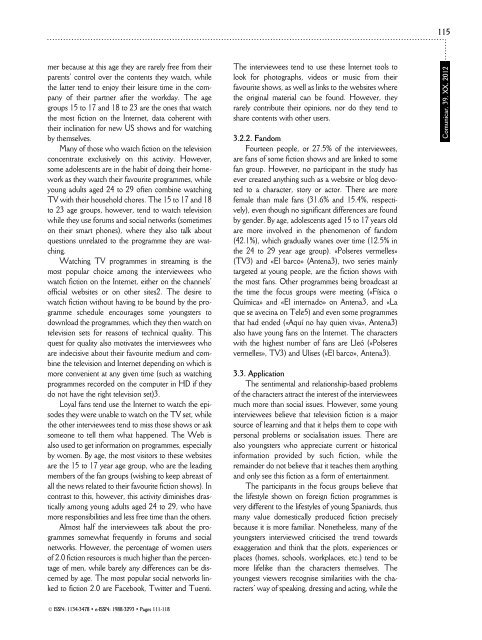Comunicar 39-ingles - Revista Comunicar
Comunicar 39-ingles - Revista Comunicar
Comunicar 39-ingles - Revista Comunicar
You also want an ePaper? Increase the reach of your titles
YUMPU automatically turns print PDFs into web optimized ePapers that Google loves.
115mer because at this age they are rarely free from theirparents’ control over the contents they watch, whilethe latter tend to enjoy their leisure time in the companyof their partner after the workday. The agegroups 15 to 17 and 18 to 23 are the ones that watchthe most fiction on the Internet, data coherent withtheir inclination for new US shows and for watchingby themselves.Many of those who watch fiction on the televisionconcentrate exclusively on this activity. However,some adolescents are in the habit of doing their homeworkas they watch their favourite programmes, whileyoung adults aged 24 to 29 often combine watchingTV with their household chores. The 15 to 17 and 18to 23 age groups, however, tend to watch televisionwhile they use forums and social networks (sometimeson their smart phones), where they also talk aboutquestions unrelated to the programme they are watching.Watching TV programmes in streaming is themost popular choice among the interviewees whowatch fiction on the Internet, either on the channels’official websites or on other sites2. The desire towatch fiction without having to be bound by the programmeschedule encourages some youngsters todownload the programmes, which they then watch ontelevision sets for reasons of technical quality. Thisquest for quality also motivates the interviewees whoare indecisive about their favourite medium and combinethe television and Internet depending on which ismore convenient at any given time (such as watchingprogrammes recorded on the computer in HD if theydo not have the right television set)3.Loyal fans tend use the Internet to watch the episodesthey were unable to watch on the TV set, whilethe other interviewees tend to miss those shows or asksomeone to tell them what happened. The Web isalso used to get information on programmes, especiallyby women. By age, the most visitors to these websitesare the 15 to 17 year age group, who are the leadingmembers of the fan groups (wishing to keep abreast ofall the news related to their favourite fiction shows). Incontrast to this, however, this activity diminishes drasticallyamong young adults aged 24 to 29, who havemore responsibilities and less free time than the others.Almost half the interviewees talk about the programmessomewhat frequently in forums and socialnetworks. However, the percentage of women usersof 2.0 fiction resources is much higher than the percentageof men, while barely any differences can be discernedby age. The most popular social networks linkedto fiction 2.0 are Facebook, Twitter and Tuenti.The interviewees tend to use these Internet tools tolook for photographs, videos or music from theirfavourite shows, as well as links to the websites wherethe original material can be found. However, theyrarely contribute their opinions, nor do they tend toshare contents with other users.3.2.2. FandomFourteen people, or 27.5% of the interviewees,are fans of some fiction shows and are linked to somefan group. However, no participant in the study hasever created anything such as a website or blog devotedto a character, story or actor. There are morefemale than male fans (31.6% and 15.4%, respectively),even though no significant differences are foundby gender. By age, adolescents aged 15 to 17 years oldare more involved in the phenomenon of fandom(42.1%), which gradually wanes over time (12.5% inthe 24 to 29 year age group). «Polseres vermelles»(TV3) and «El barco» (Antena3), two series mainlytargeted at young people, are the fiction shows withthe most fans. Other programmes being broadcast atthe time the focus groups were meeting («Física oQuímica» and «El internado» on Antena3, and «Laque se avecina on Tele5) and even some programmesthat had ended («Aquí no hay quien viva», Antena3)also have young fans on the Internet. The characterswith the highest number of fans are Lleó («Polseresvermelles», TV3) and Ulises («El barco», Antena3).3.3. ApplicationThe sentimental and relationship-based problemsof the characters attract the interest of the intervieweesmuch more than social issues. However, some younginterviewees believe that television fiction is a majorsource of learning and that it helps them to cope withpersonal problems or socialisation issues. There arealso youngsters who appreciate current or historicalinformation provided by such fiction, while theremainder do not believe that it teaches them anythingand only see this fiction as a form of entertainment.The participants in the focus groups believe thatthe lifestyle shown on foreign fiction programmes isvery different to the lifestyles of young Spaniards, thusmany value domestically produced fiction preciselybecause it is more familiar. Nonetheless, many of theyoungsters interviewed criticised the trend towardsexaggeration and think that the plots, experiences orplaces (homes, schools, workplaces, etc.) tend to bemore lifelike than the characters themselves. Theyoungest viewers recognise similarities with the characters’way of speaking, dressing and acting, while the<strong>Comunicar</strong>, <strong>39</strong>, XX, 2012© ISSN: 1134-3478 • e-ISSN: 1988-3293 • Pages 111-118
















